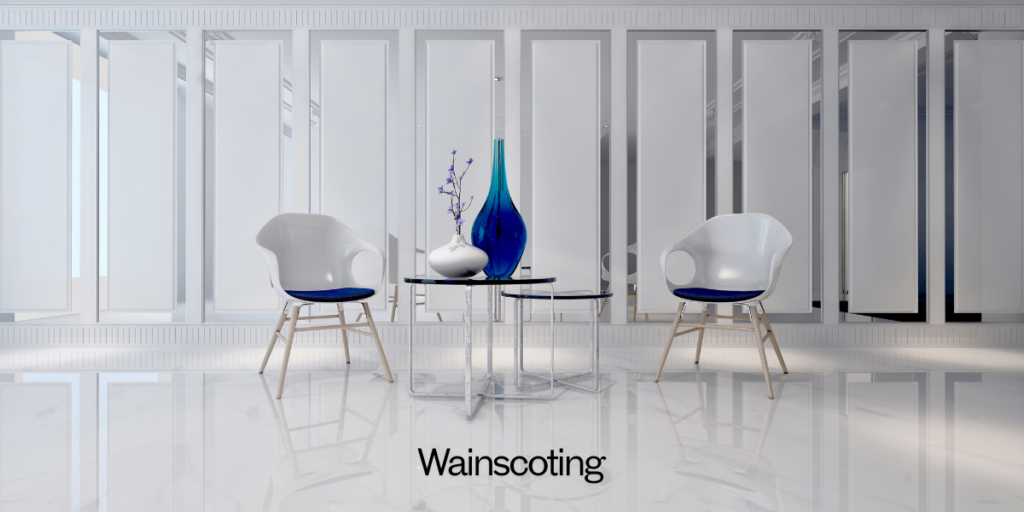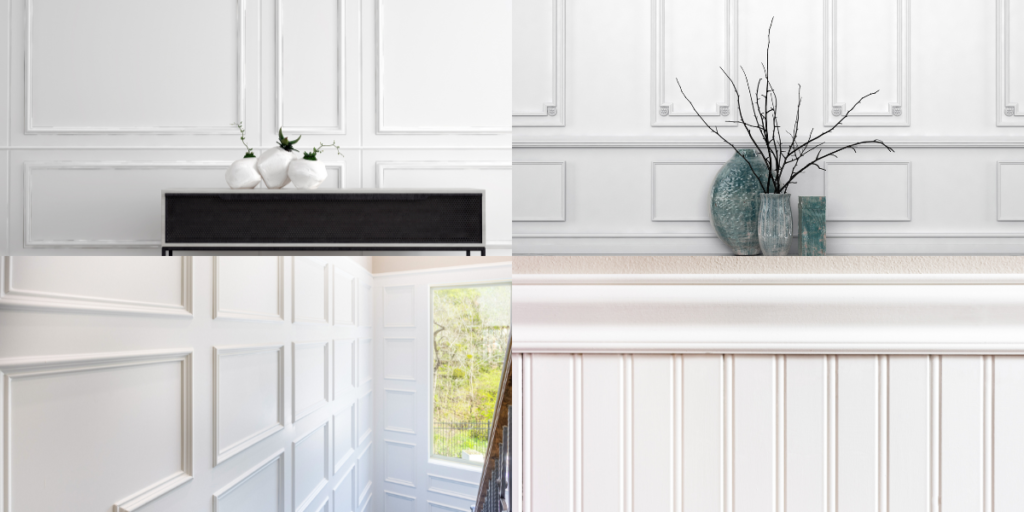Transform Your Walls with Wainscoting: A Guide to Styles and Benefits
Wainscoting is more than just a decorative wall feature—it’s an integral element of design that adds charm and protection to your living spaces. This classic treatment has been used for centuries to create a sophisticated atmosphere while providing practical benefits. Today, wainscoting continues to evolve, offering homeowners a versatile way to enhance both the beauty and functionality of their interiors.
What is Wainscoting?

This wall paneling treatment typically covers the lower third of a wall, usually ranging from 36 to 42 inches in height. Originally designed to protect walls from moisture, dirt, and damage in high-traffic areas, wainscoting has become a stylish feature that enhances any room. Materials such as wood, MDF, and PVC are commonly used, each offering its own aesthetic and practical advantages. Over time, wainscoting has evolved into a timeless design element that works in both traditional and modern spaces.
Over time, the function of wainscoting expanded beyond just protection. It became an aesthetic feature designed to add texture, depth, and elegance to walls, creating an architectural statement in any room. Its durability, visual appeal, and timeless charm are the reasons it remains a sought-after feature in both contemporary and traditional interior design.
Why is Wainscoting Still Popular?
The popularity of wainscoting is no coincidence—this design element offers both beauty and functionality that few other features can match. Its lasting appeal can be credited to several factors:
- Timeless Aesthetic: Wainscoting brings an element of traditional craftsmanship that elevates the design of any space. Whether you’re decorating a classic Victorian home or a modern apartment, it can be customized to match the room’s style.
- Adds Texture and Depth: In a room with flat, plain walls, wainscoting breaks up the monotony, adding layers of visual interest. This texture can help a small room feel more spacious and a large room feel more balanced.
- Functionality: Wainscoting offers protection to walls that endure high traffic and frequent cleaning, such as in hallways, kitchens, and bathrooms. Additionally, it shields walls from moisture, stains, and scuff marks.
- Customizability: With a range of styles, materials, and finishes, it can suit any design preference. Whether you desire a rustic, farmhouse look or an upscale, modern finish, it can be tailored to complement your home’s interior.
Different Types of Wainscoting Styles
Wainscoting is not a one-size-fits-all solution. With various styles available, you can choose the one that best fits the aesthetic of your home. Each style offers distinct visual appeal, and the right one can complement the room’s existing decor.
Raised Panel
Raised panel wainscoting is one of the most classic and elegant forms of paneling. It consists of individual panels that are set within a framework and raised above the surrounding trim. This design creates a sophisticated, regal look, making it perfect for formal spaces such as dining rooms, libraries, or grand foyers. The depth of the panels adds an element of texture and luxury, and the style works well with traditional or transitional decor.
Flat Panel
Flat panel wainscoting offers a more minimalist and modern appearance. The panels are flush with the surrounding trim, giving them a sleek, clean finish. This style is often used in contemporary spaces, such as modern kitchens, living rooms, or bathrooms, where a simple, understated look is preferred. Flat panel wainscoting is also ideal for those who want to make a statement with other elements of their design, such as furniture, lighting, or artwork.
Beadboard
Beadboard wainscoting consists of narrow vertical planks with small grooves, which gives the walls a textured, inviting feel. It’s often used in more casual spaces like bathrooms, kitchens, and mudrooms to create a light, airy, and cozy atmosphere. Beadboard works particularly well in coastal, cottage, or farmhouse-style homes, evoking a sense of warmth and charm. The look can range from rustic to refined, depending on the paint finish or stain used.
Board and Batten
Characterized by wide vertical boards separated by narrow strips, known as battens, board and batten wainscoting creates a more rustic, textured effect. This style is highly popular in farmhouse and country-inspired interiors, where its simplicity and rugged charm are appreciated. It is also effective in larger spaces where a bold, dramatic statement is desired.
Shiplap
Shiplap consists of horizontal planks with an overlapping design, giving a room a relaxed, coastal vibe. While traditionally used in exterior design, shiplap has become a beloved feature in interior design as well, particularly in modern farmhouse or coastal-style homes. It can be used for a more casual or even industrial look in rooms like the living room, kitchen, or bathroom.
The Benefits of Installing Wainscoting
The practical benefits of wainscoting extend far beyond its visual appeal. Some of the reasons homeowners continue to choose this feature for their homes include:

Durability and Protection
One of the most obvious benefits of wainscoting is the protection it offers. It shields walls from scuffs, dirt, and moisture, making it especially useful in areas like hallways, kitchens, and bathrooms. In high-traffic zones, it preserves the integrity of your walls, reducing the need for frequent touch-ups or repairs.
Increased Home Value
Adding wainscoting can enhance your home’s aesthetic appeal and potentially increase its resale value. It’s a feature that adds perceived value and sophistication, appealing to potential buyers who appreciate detailed craftsmanship and classic design.
Creates Visual Appeal
Wainscoting helps to break up large, flat wall spaces, making a room feel more cohesive and finished. It adds depth and visual interest, particularly when paired with complementary colors or patterns. The addition of wainscoting can make even the simplest room feel more polished and stylish.
Enhanced Acoustics
The added layers of wood or other materials help to absorb sound, improving the acoustics in a room. This is particularly beneficial in larger spaces or rooms that tend to echo, such as living rooms or dining areas.
Where to Use Wainscoting in Your Home
Wainscoting works in virtually every room of the home. The key is to understand how it can complement the room’s function and design.
- Dining Rooms: Wainscoting creates a sophisticated and formal atmosphere in dining areas. The raised panel style is particularly popular, adding an element of luxury that complements traditional furniture and design.
- Hallways and Entryways: These areas benefit from both the durability and visual appeal of paneling. Wainscoting helps protect walls from scuffs while creating a welcoming atmosphere.
- Kitchens and Bathrooms: Both of these high-moisture areas can benefit from wainscoting, especially styles like beadboard or shiplap. They provide protection against moisture while enhancing the room’s aesthetic.
- Living Rooms and Bedrooms: Whether you want a timeless look or a modern twist, paneling works in any living or sleeping space. The material you choose can align with the overall vibe of the room, from rustic to contemporary.
How to Choose the Right Wainscoting for Your Space
Selecting the right wainscoting depends on several factors, including the room size, your personal style, and the functionality you require. For example, smaller rooms may benefit from simpler, flatter paneling, while larger rooms can handle more intricate raised panel designs. Choose materials based on your budget and desired maintenance. For a more traditional look, wood is a great choice, while MDF offers a more affordable alternative. If you need something low-maintenance and water-resistant, PVC or vinyl may be the way to go.
Conclusion
Wainscoting is a design feature that has stood the test of time, and for good reason. Its blend of beauty, durability, and versatility makes it a perfect choice for homeowners seeking to elevate their space. Whether you’re updating a traditional room or creating a more modern look, wainscoting offers the perfect solution for adding character and functionality to your home.
FAQs
- Can wainscoting be used in small rooms?
Yes! For smaller spaces, opt for simpler styles like flat panel or bead board to avoid overwhelming the room. These styles can add texture without being too busy. - How do I maintain wainscoting?
Regular dusting and wiping with a damp cloth should keep wainscoting looking fresh. Wooden paneling may need occasional refinishing, while vinyl and MDF are low-maintenance. - Can wainscoting be installed in modern homes?
Absolutely! Modern homes often use flat panel or minimalist designs to maintain a clean and contemporary look while still enjoying the benefits of wainscoting. - What materials are commonly used for wainscoting?
Common materials include wood, MDF, and PVC. Each offers unique benefits, such as affordability (MDF) or water resistance (PVC). - Where is the best place to install wainscoting?
Wainscoting works well in areas like dining rooms, hallways, kitchens, bathrooms, and living rooms, offering both aesthetic appeal and practical protection.








Post Comment